This week’s how-to garden article and corresponding podcast are all about how to make incredible compost to help grow a great garden!
As plants grow throughout the year, they quickly deplete the nutrients within the soil. Over time, the soil is less likely to be able to provide everything the plants need. This will result in weaker, less healthy plants that will produce fewer blooms and fruit for harvesting.
There’s no doubt that adding compost to your soil is the best way to power your plants and improve their chance of having healthy and productive growth. Even better, it’s all natural, and free! Listen in to the complete compost podcast below, or read on for the full length article.
Compost is an amazing organic powerhouse of nutrients. These nutrients will help to keep the soil loose, workable, and most importantly, completely energized. And it’s a huge advantage to create the compost yourself.
While there are lots of gardening articles and tips out there, this guide will give you a simple approach to composting. It’s composting made easy and uncomplicated!
The Many Ways To Use Compost
While you might only think of using compost in your garden, there are many different ways your plants can benefit from a boost of nutrients.
When you go to pot up your hanging baskets, add a few cupfuls of compost to the potting soil mixture. Any container plant can also benefit from an addition of compost. Starting seeds indoors? Add some compost to your seed starting soil.
Planting new trees or bushes around your property? Consider adding a bit of compost before placing the tree or plant into its new location.
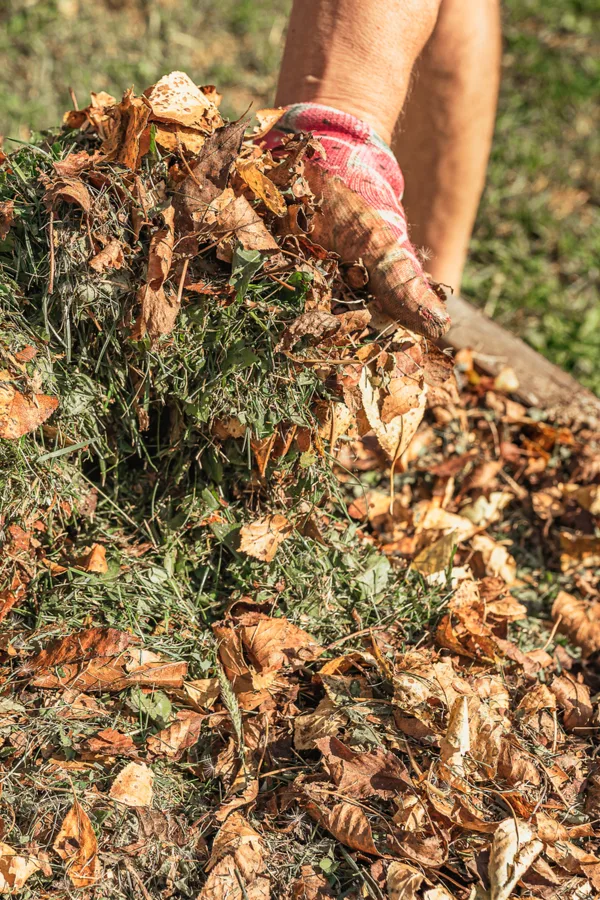
Ever heard of using compost tea with your plants? It’s a great way to naturally and organically fertilize your plants any time they need an additional boost of nutrients. With having your own compost pile on hand, you can easily make up a batch or two when needed.
Finally, as an added benefit, compost is great for using as a mulch around new plants. So, as you can easily see, there are many different ways to use this natural and organic homemade product!
Things To Consider
The fact of the matter is that all materials eventually turn into compost. Some just decompose quicker than others.
Knowing what materials work best in a home compost pile and what materials should be avoided will help to ensure your compost pile gets the most benefits and allow you to create this natural fertilizer in no time at all. (Those materials will be discussed in a little bit.)
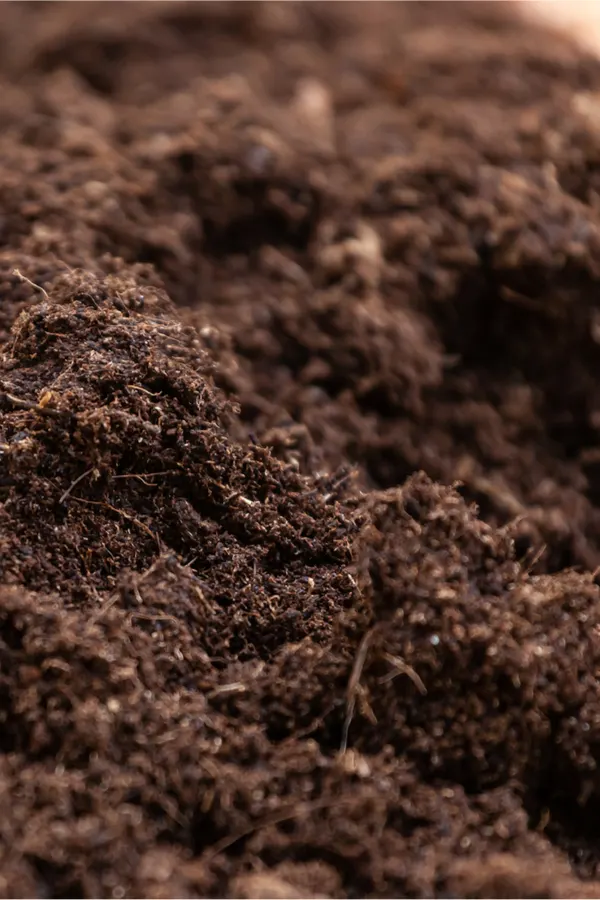
The most important thing is to not worry too much about difficult mixtures and formulas. Composting doesn’t have to be difficult, but there are a few things to take into consideration when it comes to composting.
How To Make Great Compost
Now that you know why compost is a great addition for gardening and planting, let’s figure out how to actually make it! As you will see, it’s easier than you might think!
What Type Of Container To Use
There are many different container options available that you can use for composting. One option is to purchase a pre-made container, usually a plastic barrel or tumbler.
There are a few issues with plastic barrels and tumblers, however. They are often not large enough to be able to really heat up a pile, and heat is needed in order to decompose materials.
In addition, many of these tumblers can also become easily waterlogged. Or, the opposite will occur and they don’t get enough moisture at all.
Instead of purchasing composters, you can easily make a bin from nearly any material. Old wooden stakes, chicken wire, fencing boards, untreated pallets, and even blocks or bricks work well.
The wooden compost bins shown in the image below are not only easy to make yourself, but they are also attractive as well (Single and Double Compost Bin Plans).
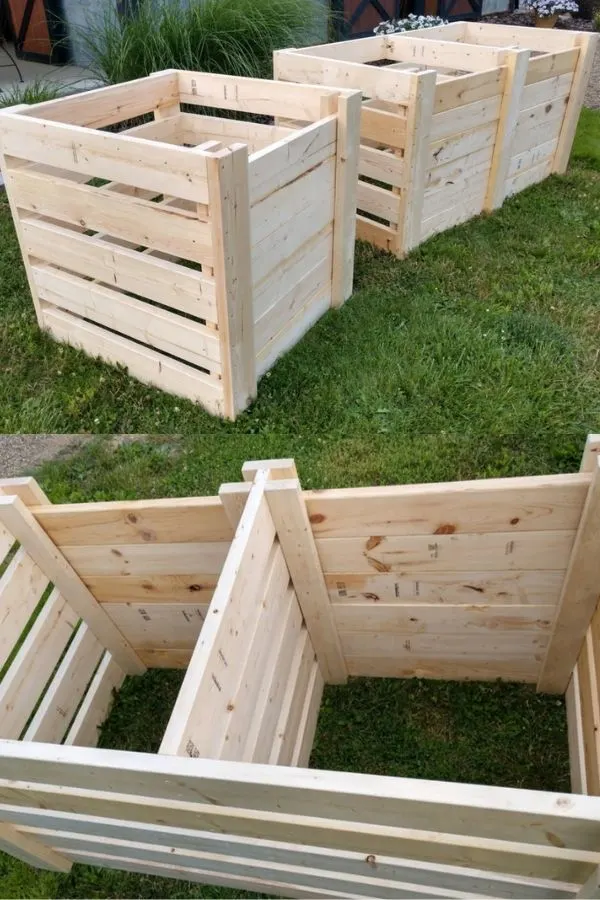
Whatever you choose, you want your home compost pile to be large enough to be able to work while still being able to adequately heat up. (The ideal size is mentioned further down in this guide.)
In addition, consider local animals, pets, etc. on whether your container will need to be covered or not.
Getting The Right Mix Of Materials
To get the most from a compost pile, it takes a proper balance of Brown and Green materials. It can all sound intimidating, but it’s actually quite simple.
Brown materials are carbon-based and can be thought of as “dead” items. Materials such as leaves, straw, wood shavings, dead grass, and small twigs are all considered brown items.
Green materials are nitrogen-based and are the “fuel” that gets the pile cooking. Materials like vegetable peels, coffee grounds, green grass, and plant clippings are all great green items. Green materials can also be animal by-products such as chicken and rabbit manures.
The Right Ratio Of Materials
Composting doesn’t need to be difficult or confusing, but there is a simple ratio to keep in mind. You want to have one part green material for every four parts brown materials.
Now, this doesn’t have to be exact nor does it have to be added all at once. Picture using a 5-gallon bucket. If you add 4 buckets of shredded leaves to the pile, then you’ll want to eventually add one bucket of vegetable peels or fresh green grass to balance it out.
Remember: 1 Part Green for Every 4 Parts Brown
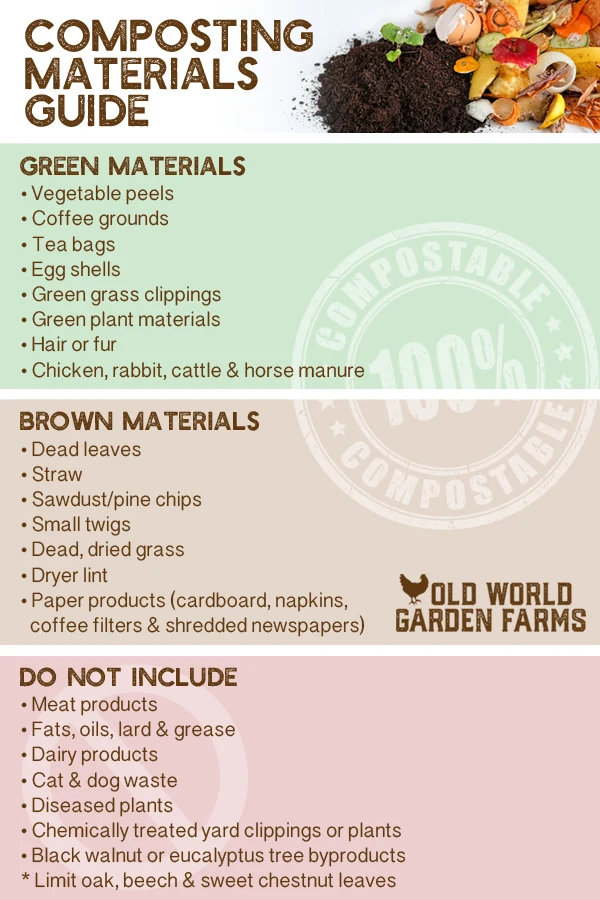
Where To Get Compost Materials
The best part of composting at home is that you don’t have to pay a dime to gather the materials. Kitchen scraps and yard waste all make for excellent compost piles.
Local coffee and breakfast shops are a great place to get discarded coffee grounds and scraps. In addition, many neighbors, friends, or family members are more than happy to give out free materials as well.
The fall is the perfect time to gather free compost materials. From leaves to natural fall decorations, all of these materials will decompose into compost. But spring and summer have their own great materials too.
Just keep in mind that there are some tree varieties that you need to avoid adding their products to your pile. Tree products such as black walnut and eucalyptus should be avoided altogether.
In addition, limit oak, beech, and sweet chestnut leaves. To learn more about composting with leaves, check out this article, “How To Make Incredible Compost From Leaves.”
What Not To Add To A Make A Great Compost Pile
Even though all materials eventually decompose, there are some items you want to avoid adding to your compost pile aside from the tree products mentioned above.
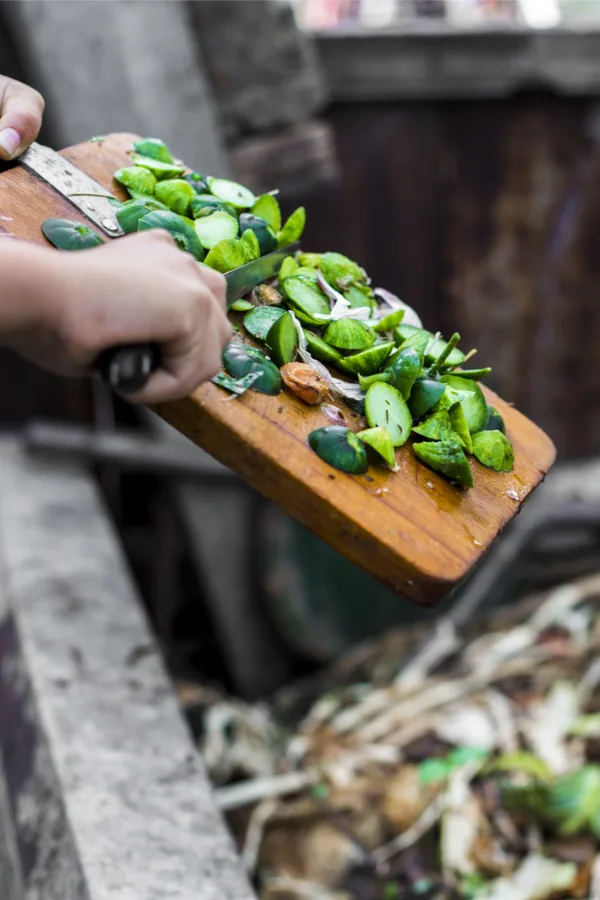
Any meat products need to be avoided in addition to oil, dairy, and butter-based items. These materials can lead to foul-smelling piles that are likely to attract insects, rats, mice, raccoons, and other unwanted animals.
While livestock animal manure is very useful in a compost pile, you don’t want to add dog or cat manure. Most at-home compost piles aren’t able to heat up high enough to kill off any pathogens that might be in pet or human feces.
Also avoid using chemically treated or diseased plant material, any parts of a tomato plant, and fruits or vegetables with a ton of seeds.
The Right Sized Pile
As mentioned earlier, if a compost pile is too small, the materials never “heat up” enough to decompose quickly. And if the pile is too big, it becomes difficult to turn and mix.
Turning and mixing is a big part of a successful pile, so you want to make your compost pile manageable. For best results, a pile should be between 3’ wide x 3’ deep x 3’ tall and 5′ x 5′ x 3′. This allows for a pile big enough to have enough thermal heat, but not so big that it’s hard to turn.
Creating Compost Quickly – Make Great Compost
There are a few things to keep in mind if you want to be able to quickly create compost that you can use in your garden. With these tips, you can easily create finished compost in less than one season.
Chop or Shred Ingredients
It’s pretty simple, the smaller the pieces, the quicker you will have compost. Reducing all of the materials in your pile is always best. This not only allows the materials to take up less space in the compost bin but also speeds up decomposition.
For example, instead of throwing in an entire whole seedless watermelon into your compost pile, chop it up into pieces that are only a few inches big. Those smaller pieces will decompose a lot quicker than a whole watermelon.
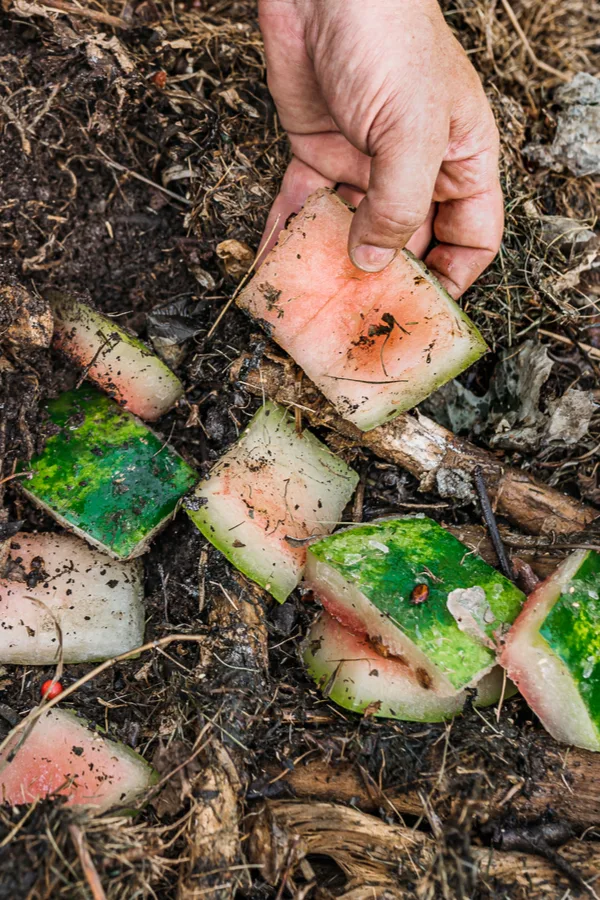
There is no need to buy expensive shredders or grinders to chop up your composting materials though. You can simply pass over them with your lawnmower a time or two to quickly shred leaves or straw into more manageable pieces.
Turn The Pile Often
In order for a compost pile to heat up, it needs to have oxygen. The best way to do this is to turn the pile frequently. “Turning” means mixing the materials up so the items on the outside of the bin get a chance to be in the middle of the pile where it gets the hottest.
Simply use a pitchfork or shovel, making sure to move the outside material to the inside and vice versa so it all gets a chance to evenly heat up.
Aim for turning your compost pile at least once a week. During the heat of summer, it is best to turn the pile a few times each week if possible. Once the pile has frozen in the winter, there is no need to turn it again until the weather warms back up.
Keep The Pile Moist
In addition to oxygen, it’s vital to keep the pile moist. Compost needs moisture to keep it heated up and cooking. A good compost pile should feel like a slightly damp sponge in the middle. The edges are likely to dry out, but as long as the middle is moist and not saturated, that’s the key.
To help retain moisture, cover the pile with a damp burlap bag or a thick layer of straw. If the pile is getting too much moisture from rainfall, then consider a more permanent cover or lid.
Use a 2- or 3-Bin System
While you can definitely use only a one-bin system if you are short on space, consider a two or three-bin system if possible. These systems allow you to always have a spot for adding new material and a spot for your finished or almost finished compost that is ready to be used.
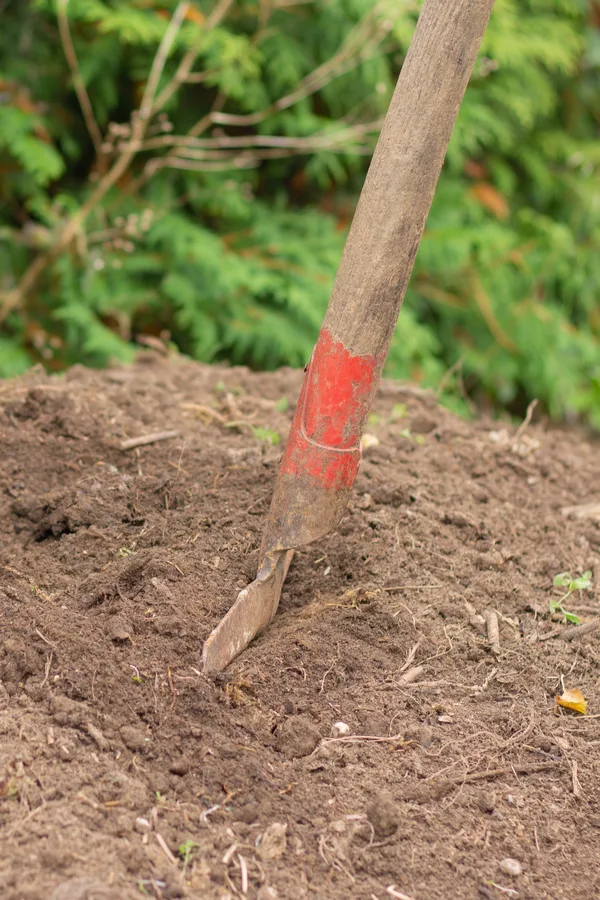
With a two-bin system, you will always have one bin of compost finishing off or ready to use and one bin where you add any new materials.
A three-bin system allows you to have one bin that has your finished compost, one bin for your almost finished compost, and one where you are adding your brand new material.
In Conclusion . . .
Yes, everything does eventually decompose. However, following these few simple tips will allow you to quickly make amazing compost that will power your plants and keep them looking beautiful and healthy!
Follow Our Facebook Page For Even More Great Tips! Simple Garden Life Facebook Page
Simple Garden Life is a website dedicated to keeping gardening fun, simple and enjoyable! We publish two new articles each week along with a new garden podcast episode every two weeks. This article may contain affiliate links.
